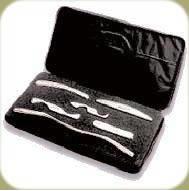Many golfers, week in and week out, suffer from golf related over-use injuries and are not sure how this occurs, and more importantly, how to prevent these injuries. The key to prevention lies in the understanding of what causes over-use injury and what to do to prepare the body for the demands of the golf swing. Most golf related injuries will be due to over-use or repetitive strain placed on the body. A perfect golf swing is demanding to the body and is all too often exacerbated by poor muscular balance, poor swing mechanics, excessive practice, poor nutrition, and/or improper club fitting. This article will focus on the Body-Swing relationship and how to put the pieces together to prevent injury and optimize performance.
 |
| Cumulative Injury Cycle |
To understand over-use golf injuries, one must know how the injury process occurs in the body. The Cumulative Injury Cycle (above) represents the process in which over-use injuries and pain occur. This cycle is not limited to golf, but will be for the purposes of this article. The process begins with Overwork, such as the golf swing, especially a golf swing that is not technically sound. The golf swing combined with a sedentary lifestyle or other repetitive activities then leads to Weak & Tight Muscles. These weak and/or tight muscles lead to excessive Friction, Pressure and Tension to the local muscles, ligaments, tendons, and discs. In turn, this results in Decreased Circulation, Swelling and Hypoxia (lack of oxygen) to the area. Due to a lack of oxygen to the tissue, formation of adhesions and/or scar tissue occurs to the area which decreases the function of the local structures. If dysfunction in the muscles continues, injury most likely will occur in the golfer at some point.
To determine if a golfer is susceptible to an over-use injury, or what caused the injury, a full evaluation should include a concise medical evaluation, video swing analysis, and a golf physical screening. The video analysis should be performed when the golfer can swing normally without any pain. As a doctor, I am not video taping the golf swing for instruction purpose, but rather to investigate any swing faults that may lead to or a cause of an injury. The video swing analysis is then paired with a golf physical screening to determine any weak muscles, tight muscles and movement pattern deficiencies. If on video we detect a swing fault (improper swing mechanics that place undue stress on the body), we then cross check it with the physical screening to see if a physical limitation is the cause of the swing fault. Many swing faults are caused by physical limitations such as lack of mobility, core stability, muscular strength or joint dysfunction. To summarize, we are looking for a physical limitation that is causing a swing fault, and the combination of physical limitation and swing fault increases the chance of over-use injury.
Below is an example of Golfer’s Elbow (Medial Epicondylitis) and a few swing faults and physical limitations that cause it. There are more causes for this injury, but we will just cover a few.
Golfer’s elbow is an inflammation at the inside aspect of the elbow.
Chicken Winging: The lead arm doesn’t fully extend into impact. This causes excessive forces at the elbow in both arms.
 |
| Chicken Winging |
Over-the-Top: The plane of the downswing is too steep. This causes the lead wrist to extend and the lead elbow to flex causing excessive loads to the forearm muscles. This swing fault usually indicates excessive use of the arms in the golf swing as well.
 |
| Over-the-top |
Casting: Early release of the proper wrist angles prior to impact. This places excessive forces on the trail arm forearm flexors.
 |
| Casting/Early Release |
Dysfunctional Lower Body- The inability to optimally fire and utilize the hips and legs in the golf swing is the main cause of chicken winging, scooping, and over-the-top swing faults. The lack of power production from the lower body forces the upper body to over compensate and leads to over-use strain of the upper extremity. Also, the inability to separate the pelvis independently of the torso will cause early initiation of the upper body/upper extremity in the golf swing. This will produce an upper body dominant golf swing. We must evaluate the lower body when elbow or shoulder injuries occur. Full evaluation of the wrist, forearm and shoulder would be performed for Golfer’s Elbow as well.
As you can see, getting to the bottom of golf related over-use injuries and preventing them must take into consideration all possible causes of injury. They must then be addressed through manual therapy, corrective exercises, therapeutic modalities and sometimes even lessons and club fitting. So, the key to injury prevention is to address all these factors before the injury occurs!








